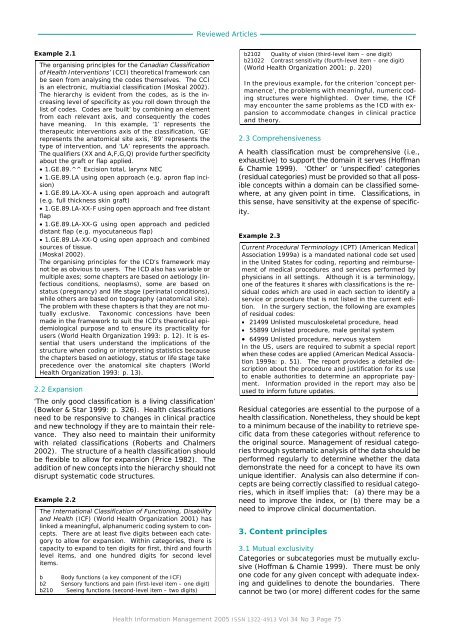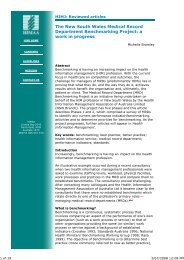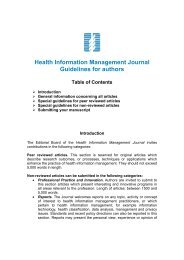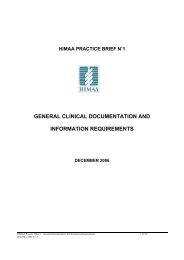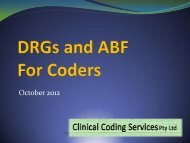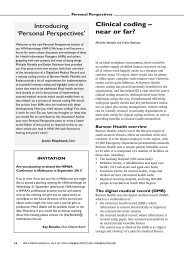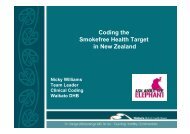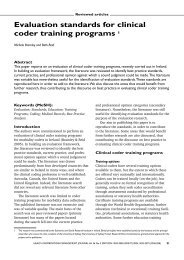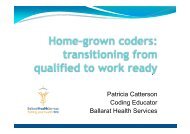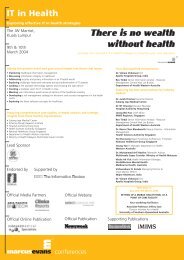A framework for evaluating health classifications - Health Information ...
A framework for evaluating health classifications - Health Information ...
A framework for evaluating health classifications - Health Information ...
You also want an ePaper? Increase the reach of your titles
YUMPU automatically turns print PDFs into web optimized ePapers that Google loves.
Reviewed Articles<br />
Example 2.1<br />
The organising principles <strong>for</strong> the Canadian Classification<br />
of <strong>Health</strong> Interventions’ (CCI) theoretical <strong>framework</strong> can<br />
be seen from analysing the codes themselves. The CCI<br />
is an electronic, multiaxial classification (Moskal 2002).<br />
The hierarchy is evident from the codes, as is the increasing<br />
level of specificity as you roll down through the<br />
list of codes. Codes are ‘built’ by combining an element<br />
from each relevant axis, and consequently the codes<br />
have meaning. In this example, ‘1’ represents the<br />
therapeutic interventions axis of the classification, ‘GE’<br />
represents the anatomical site axis, ‘89’ represents the<br />
type of intervention, and ‘LA’ represents the approach.<br />
The qualifiers (XX and A,F,G,Q) provide further specificity<br />
about the graft or flap applied.<br />
• 1.GE.89.^^ Excision total, larynx NEC<br />
• 1.GE.89.LA using open approach (e.g. apron flap incision)<br />
• 1.GE.89.LA-XX-A using open approach and autograft<br />
(e.g. full thickness skin graft)<br />
• 1.GE.89.LA-XX-F using open approach and free distant<br />
flap<br />
• 1.GE.89.LA-XX-G using open approach and pedicled<br />
distant flap (e.g. myocutaneous flap)<br />
• 1.GE.89.LA-XX-Q using open approach and combined<br />
sources of tissue.<br />
(Moskal 2002).<br />
The organising principles <strong>for</strong> the ICD’s <strong>framework</strong> may<br />
not be as obvious to users. The ICD also has variable or<br />
multiple axes; some chapters are based on aetiology (infectious<br />
conditions, neoplasms), some are based on<br />
status (pregnancy) and life stage (perinatal conditions),<br />
while others are based on topography (anatomical site).<br />
The problem with these chapters is that they are not mutually<br />
exclusive. Taxonomic concessions have been<br />
made in the <strong>framework</strong> to suit the ICD’s theoretical epidemiological<br />
purpose and to ensure its practicality <strong>for</strong><br />
users (World <strong>Health</strong> Organization 1993: p. 12). It is essential<br />
that users understand the implications of the<br />
structure when coding or interpreting statistics because<br />
the chapters based on aetiology, status or life stage take<br />
precedence over the anatomical site chapters (World<br />
<strong>Health</strong> Organization 1993: p. 13).<br />
2.2 Expansion<br />
‘The only good classification is a living classification’<br />
(Bowker & Star 1999: p. 326). <strong>Health</strong> <strong>classifications</strong><br />
need to be responsive to changes in clinical practice<br />
and new technology if they are to maintain their relevance.<br />
They also need to maintain their uni<strong>for</strong>mity<br />
with related <strong>classifications</strong> (Roberts and Chalmers<br />
2002). The structure of a <strong>health</strong> classification should<br />
be flexible to allow <strong>for</strong> expansion (Price 1982). The<br />
addition of new concepts into the hierarchy should not<br />
disrupt systematic code structures.<br />
Example 2.2<br />
The International Classification of Functioning, Disability<br />
and <strong>Health</strong> (ICF) (World <strong>Health</strong> Organization 2001) has<br />
linked a meaningful, alphanumeric coding system to concepts.<br />
There are at least five digits between each category<br />
to allow <strong>for</strong> expansion. Within categories, there is<br />
capacity to expand to ten digits <strong>for</strong> first, third and fourth<br />
level items, and one hundred digits <strong>for</strong> second level<br />
items.<br />
b<br />
b2<br />
b210<br />
Body functions (a key component of the ICF)<br />
Sensory functions and pain (first-level item – one digit)<br />
Seeing functions (second-level item – two digits)<br />
b2102 Quality of vision (third-level item – one digit)<br />
b21022 Contrast sensitivity (fourth-level item – one digit)<br />
(World <strong>Health</strong> Organization 2001: p. 220)<br />
In the previous example, <strong>for</strong> the criterion ‘concept permanence’,<br />
the problems with meaningful, numeric coding<br />
structures were highlighted. Over time, the ICF<br />
may encounter the same problems as the ICD with expansion<br />
to accommodate changes in clinical practice<br />
and theory.<br />
2.3 Comprehensiveness<br />
A <strong>health</strong> classification must be comprehensive (i.e.,<br />
exhaustive) to support the domain it serves (Hoffman<br />
& Chamie 1999). ‘Other’ or ‘unspecified’ categories<br />
(residual categories) must be provided so that all possible<br />
concepts within a domain can be classified somewhere,<br />
at any given point in time. Classifications, in<br />
this sense, have sensitivity at the expense of specificity.<br />
Example 2.3<br />
Current Procedural Terminology (CPT) (American Medical<br />
Association 1999a) is a mandated national code set used<br />
in the United States <strong>for</strong> coding, reporting and reimbursement<br />
of medical procedures and services per<strong>for</strong>med by<br />
physicians in all settings. Although it is a terminology,<br />
one of the features it shares with <strong>classifications</strong> is the residual<br />
codes which are used in each section to identify a<br />
service or procedure that is not listed in the current edition.<br />
In the surgery section, the following are examples<br />
of residual codes:<br />
• 21499 Unlisted musculoskeletal procedure, head<br />
• 55899 Unlisted procedure, male genital system<br />
• 64999 Unlisted procedure, nervous system<br />
In the US, users are required to submit a special report<br />
when these codes are applied (American Medical Association<br />
1999a: p. 51). The report provides a detailed description<br />
about the procedure and justification <strong>for</strong> its use<br />
to enable authorities to determine an appropriate payment.<br />
In<strong>for</strong>mation provided in the report may also be<br />
used to in<strong>for</strong>m future updates.<br />
Residual categories are essential to the purpose of a<br />
<strong>health</strong> classification. Nonetheless, they should be kept<br />
to a minimum because of the inability to retrieve specific<br />
data from these categories without reference to<br />
the original source. Management of residual categories<br />
through systematic analysis of the data should be<br />
per<strong>for</strong>med regularly to determine whether the data<br />
demonstrate the need <strong>for</strong> a concept to have its own<br />
unique identifier. Analysis can also determine if concepts<br />
are being correctly classified to residual categories,<br />
which in itself implies that: (a) there may be a<br />
need to improve the index, or (b) there may be a<br />
need to improve clinical documentation.<br />
3. Content principles<br />
3.1 Mutual exclusivity<br />
Categories or subcategories must be mutually exclusive<br />
(Hoffman & Chamie 1999). There must be only<br />
one code <strong>for</strong> any given concept with adequate indexing<br />
and guidelines to denote the boundaries. There<br />
cannot be two (or more) different codes <strong>for</strong> the same<br />
<strong>Health</strong> In<strong>for</strong>mation Management 2005 ISSN 1322-4913 Vol 34 No 3 Page 75


